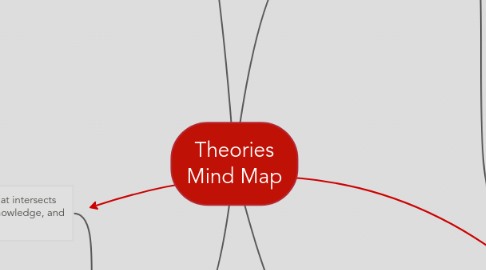
1. Technology Theories
1.1. Social Construction of Technology (SCOT)
1.1.1. Technology theory that suggests technology is directly influenced and changed by society and human action
1.1.2. For example, if a technology is outdated or of no use to society, it is often forgotten about
1.1.3. Response to Media Ecology
1.2. Media Ecology
1.2.1. Technology theory that simply suggests that society is influenced by technology
1.2.2. Study of how media communication affects human understanding and perception
1.2.3. Divided into two types of media
1.2.3.1. Cool media
1.2.3.1.1. Learner is actively involved
1.2.3.1.2. Low Definition
1.2.3.2. Hot Media
1.2.3.2.1. Little involvement required from learner
1.2.3.2.2. High Definition
2. TPACK
2.1. TPACK is the teaching technique that intersects an educators pedagogy, content knowledge, and their use of technology.
2.1.1. TPK = technology/pedagogy
2.1.2. TCK = technology/content
2.1.3. CPK = content/pedagogy
2.1.4. TPCK = the intersection of technology/pedagogy/content
2.2. Educators today need to master the TPCK domain in order to keep their students interested and engaged
2.3. Strong TPCK:
2.3.1. Knowledgeable about the subject material
2.3.2. A clear and strong pedagogy
2.3.3. Appropriate and beneficial use of technology. Not too much, nor too little
3. Learning Theories
3.1. Constructivist
3.1.1. Learner is constantly reconstructing understanding and creating new ideas
3.1.2. Learner builds connections between ideas by interacting with the environment (constructs knowledge from experiences)
3.1.3. Time-consuming, difficult to assess, and often time requires mature learners
3.2. Cognitive Load
3.2.1. Long-Term Memory
3.2.1.1. Where we store our long term knowledge so it is easily accessible in the future
3.2.2. Working Memory
3.2.2.1. Used to take in new information which is then later moved to long-term memory
3.2.2.2. Consists of extraneous, intrinsic, and germane cognitive load
3.2.2.3. Can be "overloaded" with information, teachers must be aware of how much information they are presenting and how they present it
3.2.2.3.1. Must use tactics such as chunking and make use of different learning structures
3.2.3. Focuses mainly on cognitive domain of Bloom's taxonomy, often times affective and psychomotor are ignored
3.3. Connectivism
3.3.1. A new learning theory for the digital age, originating in 2006 from theorists George Siemens and Stephen Downes
3.3.2. Stresses that knowledge is distributed across a network of connections
3.3.2.1. The ability to make these connections, know where to look for information, and being able to see connections between ideas are key skills needed to use this learning theory
3.3.2.2. Connections need to be maintained if continutal learning is to take place
3.3.3. By integrating social media such as Facebook and Twitter into classrooms, chances of distraction are much higher for students
